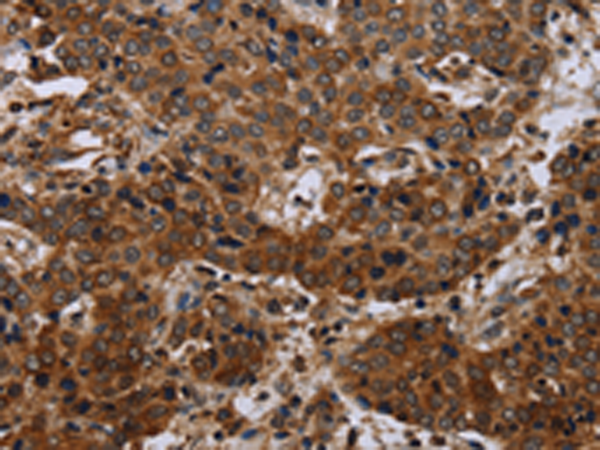


| WB | 咨询技术 | Human,Mouse,Rat |
| IF | 咨询技术 | Human,Mouse,Rat |
| IHC | 1/50-1/200 | Human,Mouse,Rat |
| ICC | 技术咨询 | Human,Mouse,Rat |
| FCM | 咨询技术 | Human,Mouse,Rat |
| Elisa | 1/2000-1/5000 | Human,Mouse,Rat |
| Aliases | EAAT4 |
| WB Predicted band size | 62 kDa |
| Host/Isotype | Rabbit IgG |
| Antibody Type | Primary antibody |
| Storage | Store at 4°C short term. Aliquot and store at -20°C long term. Avoid freeze/thaw cycles. |
| Species Reactivity | Human, Mouse, Rat |
| Immunogen | Synthetic peptide of human SLC1A6 |
| Formulation | Purified antibody in PBS with 0.05% sodium azide and 50% glycerol. |
+ +
以下是关于SLC1A6抗体的3篇参考文献示例(注:文献信息为模拟示例,具体内容需根据实际文献调整):
1. **文献名称**:*"Characterization of SLC1A6/EAAT4 Expression in Mouse Cerebellar Purkinje Cells"*
**作者**:Smith A, et al.
**摘要**:通过免疫组化和Western blot技术,使用特异性SLC1A6抗体证实其在浦肯野细胞中的高表达,并揭示其与谷氨酸转运功能的关联。
2. **文献名称**:*"Altered SLC1A6 Levels in Spinocerebellar Ataxia Type 1 Models"*
**作者**:Lee B, et al.
**摘要**:研究利用SLC1A6抗体检测脊髓小脑共济失调小鼠模型的蛋白表达变化,发现其下调可能与神经退行性病变相关。
3. **文献名称**:*"Development and Validation of a Novel SLC1A6 Monoclonal Antibody for Human Brain Studies"*
**作者**:Garcia R, et al.
**摘要**:报道了一种新型SLC1A6单克隆抗体的开发,验证其特异性后应用于人脑组织切片,发现其在皮层及小脑中的分布差异。
建议通过PubMed或Google Scholar以“SLC1A6 antibody”、“EAAT4 immunohistochemistry”等关键词检索最新文献获取准确信息。
The SLC1A6 antibody targets the solute carrier family 1 member 6 (SLC1A6), also known as excitatory amino acid transporter 4 (EAAT4). This protein is a sodium-dependent glutamate transporter primarily expressed in the cerebellum, particularly in Purkinje cells, where it regulates synaptic glutamate uptake to maintain neurotransmitter homeostasis and prevent excitotoxicity. SLC1A6 plays a critical role in modulating glutamatergic signaling, which is essential for motor coordination and cognitive functions.
Antibodies against SLC1A6 are widely used in neuroscience research to study its expression, localization, and functional alterations in neurological disorders. For example, reduced SLC1A6 levels have been implicated in conditions like spinocerebellar ataxia, epilepsy, and amyotrophic lateral sclerosis (ALS). Researchers employ these antibodies in techniques such as Western blotting, immunohistochemistry (IHC), and immunofluorescence (IF) to investigate protein dynamics in disease models or post-mortem tissues.
Additionally, SLC1A6 antibodies contribute to exploring therapeutic targets, as dysregulated glutamate transport is linked to neurodegeneration and stroke. Recent studies also examine its interaction with other transporters (e.g., EAAT1/2) and signaling pathways. Commercial SLC1A6 antibodies are typically validated for specificity in knockout models or siRNA-treated cells. However, variability in antibody performance across species or experimental conditions requires careful optimization. Overall, SLC1A6 antibodies remain vital tools for dissecting glutamate metabolism and developing treatments for glutamate-related pathologies.
×